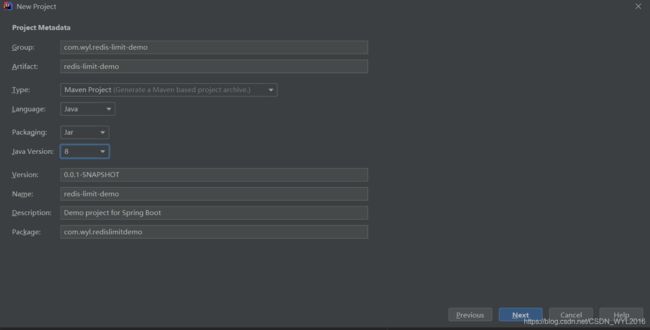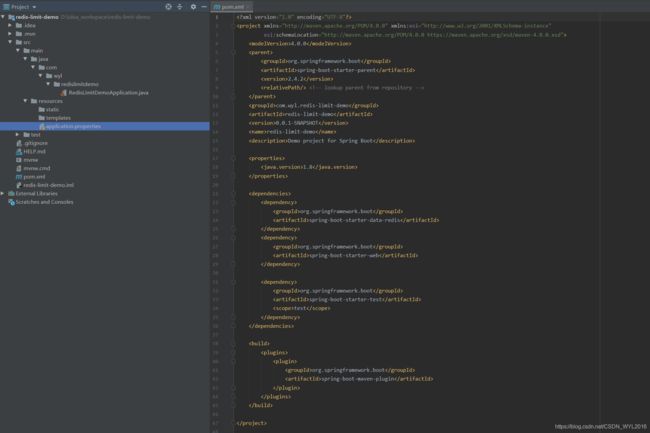Redis应用实战---通过注解完成方法+IP的限流
前言
在高并发的场景中,接口限流一般是必不可少的,一方面是为了保护系统的安全,避免某个点出问题造成雪崩效应,另一方面也可以防止一些恶意或者非正常的请求,当然有时候与第三方打交道时,也会遇到第三方接口限制访问次数的场景,这也是限流的一种使用场景。
限流算法
1、计数器
2、漏桶算法
3、令牌桶算法
限流的算法逻辑都比较简单,本文不做详细介绍,不理解的可以自行查阅相关资料,本次Redis应用实战参考gateway网关的实现方式,采用令牌桶算法实现。
环境准备
使用start.spring.io快速构建一个springboot项目
代码实现
1、先准备一个自定义的限流注解
import java.lang.annotation.*;
/**
* 限流注解,基于令牌桶算法实现
*/
@Target({
ElementType.TYPE, ElementType.METHOD})
@Retention(RetentionPolicy.RUNTIME)
@Documented
public @interface RateLimit {
/**
* 限流唯一标识(请求的ip+方法类+方法名+key)
*
* @return
*/
String key() default "";
/**
* 生成令牌的速率
* @return
*/
int replenishRate();
/**
* 总容量
* @return
*/
int burstCapacity();
}
自义定拦截器,处理所有带RateLimit注解的方法,因为要用到AOP,所以先引入AOP相关的jar包
<dependency>
<groupId>org.springframework.bootgroupId>
<artifactId>spring-boot-starter-aopartifactId>
dependency>
RateLimitAspect 切面
RateLimitAspect切面类,对标有RateLimit注解的方法做处理。
import com.wyl.redislimitdemo.annotation.RateLimit;
import com.wyl.redislimitdemo.util.IPUtil;
import org.aspectj.lang.ProceedingJoinPoint;
import org.aspectj.lang.annotation.Around;
import org.aspectj.lang.annotation.Aspect;
import org.aspectj.lang.annotation.Pointcut;
import org.aspectj.lang.reflect.MethodSignature;
import org.springframework.context.annotation.Configuration;
import org.springframework.data.redis.core.RedisTemplate;
import org.springframework.data.redis.core.script.DefaultRedisScript;
import org.springframework.web.context.request.RequestContextHolder;
import org.springframework.web.context.request.ServletRequestAttributes;
import javax.annotation.Resource;
import javax.servlet.http.HttpServletRequest;
import java.io.Serializable;
import java.lang.reflect.Method;
import java.time.Instant;
import java.util.Arrays;
import java.util.List;
import java.util.Objects;
@Aspect
@Configuration
public class RateLimitAspect {
@Resource
private RedisTemplate<String, Serializable> redisTemplate;
@Resource
private DefaultRedisScript<Long> redisLuaScript;
@Pointcut(value = "execution(* com.wyl.redislimitdemo.controller ..*(..) )")
public void rateLimit() {
}
@Around(value = "rateLimit()")
public Object methodAround(ProceedingJoinPoint joinPoint) throws Throwable {
MethodSignature signature = (MethodSignature) joinPoint.getSignature();
//获取拦截的方法名
Method method = signature.getMethod();
//获取拦截的方法所属于的类
Class<?> targetClass = method.getDeclaringClass();
RateLimit rateLimit = method.getAnnotation(RateLimit.class);
if (rateLimit != null) {
//获取request对象
HttpServletRequest request = ((ServletRequestAttributes) Objects.requireNonNull(RequestContextHolder.getRequestAttributes())).getRequest();
//根据request获取ip
String ipAddress = IPUtil.getIPAddress(request);
//拼接唯一key
String id = ipAddress + "-" + targetClass.getName() + "- " + method.getName() + "-" + rateLimit.key();
//准备执行lua脚本需要的参数
List<String> keys = Arrays.asList(id + ".tokens", id + ".timestamp", rateLimit.replenishRate() + "", rateLimit.burstCapacity() + "", Instant.now().getEpochSecond() + "", "1");
Long number = redisTemplate.execute(redisLuaScript, keys);
if (number != null && number.intValue() != 0) {
return joinPoint.proceed();
}
} else {
return joinPoint.proceed();
}
System.out.println("达到限流的最大阈值,禁止访问!");
return "达到限流的最大阈值,禁止访问!";
}
}
IP工具类
百度找的,根据request获取客户端ip地址。
package com.wyl.redislimitdemo.util;
import javax.servlet.http.HttpServletRequest;
/**
* 根据request获取客户端ip地址
*/
public class IPUtil {
public static String getIPAddress(HttpServletRequest request) {
String ip = null;
//X-Forwarded-For:Squid 服务代理
String ipAddresses = request.getHeader("X-Forwarded-For");
if (ipAddresses == null || ipAddresses.length() == 0 || "unknown".equalsIgnoreCase(ipAddresses)) {
//Proxy-Client-IP:apache 服务代理
ipAddresses = request.getHeader("Proxy-Client-IP");
}
if (ipAddresses == null || ipAddresses.length() == 0 || "unknown".equalsIgnoreCase(ipAddresses)) {
//WL-Proxy-Client-IP:weblogic 服务代理
ipAddresses = request.getHeader("WL-Proxy-Client-IP");
}
if (ipAddresses == null || ipAddresses.length() == 0 || "unknown".equalsIgnoreCase(ipAddresses)) {
//HTTP_CLIENT_IP:有些代理服务器
ipAddresses = request.getHeader("HTTP_CLIENT_IP");
}
if (ipAddresses == null || ipAddresses.length() == 0 || "unknown".equalsIgnoreCase(ipAddresses)) {
//X-Real-IP:nginx服务代理
ipAddresses = request.getHeader("X-Real-IP");
}
//有些网络通过多层代理,那么获取到的ip就会有多个,一般都是通过逗号(,)分割开来,并且第一个ip为客户端的真实IP
if (ipAddresses != null && ipAddresses.length() != 0) {
ip = ipAddresses.split(",")[0];
}
//还是不能获取到,最后再通过request.getRemoteAddr();获取
if (ip == null || ip.length() == 0 || "unknown".equalsIgnoreCase(ipAddresses)) {
ip = request.getRemoteAddr();
}
return ip.equals("0:0:0:0:0:0:0:1") ? "127.0.0.1" : ip;
}
}
redisTemplate、redisLuaScript
import com.fasterxml.jackson.annotation.JsonAutoDetect;
import com.fasterxml.jackson.annotation.PropertyAccessor;
import com.fasterxml.jackson.databind.ObjectMapper;
import org.springframework.context.annotation.Bean;
import org.springframework.context.annotation.Configuration;
import org.springframework.core.io.ClassPathResource;
import org.springframework.data.redis.connection.lettuce.LettuceConnectionFactory;
import org.springframework.data.redis.core.RedisTemplate;
import org.springframework.data.redis.core.script.DefaultRedisScript;
import org.springframework.data.redis.serializer.Jackson2JsonRedisSerializer;
import org.springframework.data.redis.serializer.RedisSerializer;
import org.springframework.data.redis.serializer.StringRedisSerializer;
import org.springframework.scripting.support.ResourceScriptSource;
@Configuration
public class RedisConfig {
@Bean
public RedisTemplate<String, Object> redisTemplate(LettuceConnectionFactory lettuceConnectionFactory) {
Jackson2JsonRedisSerializer<Object> jackson2JsonRedisSerializer = new Jackson2JsonRedisSerializer(Object.class);
ObjectMapper om = new ObjectMapper();
om.setVisibility(PropertyAccessor.ALL, JsonAutoDetect.Visibility.ANY);
om.enableDefaultTyping(ObjectMapper.DefaultTyping.NON_FINAL);
jackson2JsonRedisSerializer.setObjectMapper(om);
RedisTemplate<String, Object> redisTemplate = new RedisTemplate();
redisTemplate.setConnectionFactory(lettuceConnectionFactory);
RedisSerializer<?> stringSerializer = new StringRedisSerializer();
redisTemplate.setKeySerializer(stringSerializer);
redisTemplate.setValueSerializer(jackson2JsonRedisSerializer);
redisTemplate.setHashKeySerializer(stringSerializer);
redisTemplate.setHashValueSerializer(jackson2JsonRedisSerializer);
redisTemplate.afterPropertiesSet();
return redisTemplate;
}
@Bean
public DefaultRedisScript<Long> redisLuaScript() {
DefaultRedisScript<Long> redisScript = new DefaultRedisScript<>();
redisScript.setScriptSource(new ResourceScriptSource(new ClassPathResource("request_rate_limiter.lua")));
//返回类型
redisScript.setResultType(Long.class);
return redisScript;
}
}
Lua脚本,完成限流逻辑处理
request_rate_limiter.lua脚本,参考gateway实现令牌桶限流的算法
脚本内容
local tokens_key = KEYS[1]
local timestamp_key = KEYS[2]
local rate = tonumber(KEYS[3])
local capacity = tonumber(KEYS[4])
local now = tonumber(KEYS[5])
local requested = tonumber(KEYS[6])
local fill_time = capacity/rate
local ttl = math.floor(fill_time*2)
local last_tokens = tonumber(redis.call("get", tokens_key))
if last_tokens == nil then
last_tokens = capacity
end
local last_refreshed = tonumber(redis.call("get", timestamp_key))
if last_refreshed == nil then
last_refreshed = 0
end
local delta = math.max(0, now-last_refreshed)
local filled_tokens = math.min(capacity, last_tokens+(delta*rate))
local allowed = filled_tokens >= requested
local new_tokens = filled_tokens
local allowed_num = 0
if allowed then
new_tokens = filled_tokens - requested
allowed_num = 1
end
redis.call("setex", tokens_key, ttl, new_tokens)
redis.call("setex", timestamp_key, ttl, now)
return allowed_num
配置文件
最后配置文件中配置一下redis连接
spring.application.name=redis-limit-demo
# Redis数据库索引 默认为0
spring.redis.database=0
# Redis地址
spring.redis.host=10.0.0.150
# Redis端口 默认6379
spring.redis.port=6379
# Redis服务器连接密码(默认为空)
#spring.redis.password=12345678
项目最终结构
测试
测试接口
import com.wyl.redislimitdemo.annotation.RateLimit;
import org.springframework.web.bind.annotation.RequestMapping;
import org.springframework.web.bind.annotation.RestController;
@RestController
public class RedisLimitController {
/**
* 总容量5个令牌,一秒生成一个
*/
@RequestMapping("/limitTest")
@RateLimit(key = "limitTest", replenishRate = 1, burstCapacity = 5)
public String limitTest(){
System.out.println("执行了业务方法!");
return "执行了业务方法!";
}
}
演示效果,模拟6个并发请求,最终有1个并发请求被限流。









